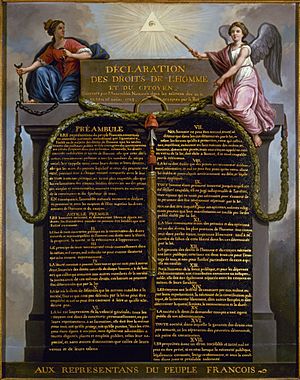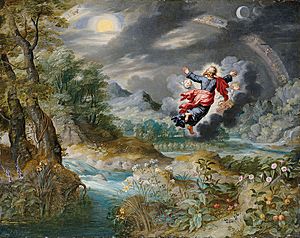Rights facts for kids
A right is something a person has that people believe should not be taken away from them. It's different from a privilege, which is something you have to earn.
Contents
What Are Rights?
Rights are like special rules that protect people. They make sure everyone is treated fairly and can live freely.
Examples of Rights
- People often have a "right to property." This means others cannot steal their belongings.
- In many countries, people have a "right to free speech." This means they can say what they want without others stopping them.
Different Kinds of Rights
There are many ways to think about rights. For example, some rights are about what you can do, like the right to vote. Other rights are about what others cannot do to you, like the right to be left alone.
Natural Rights vs. Legal Rights
- Natural rights are rights that are thought to come from human nature itself or from a higher power. They are universal, meaning they apply to everyone, everywhere. They cannot be taken away. An example is the natural right to life. These are sometimes called moral rights.
- Legal rights are based on a society's rules, laws, or actions by governments. An example is the right to vote for citizens. Legal rights can change from one country to another because they depend on the specific laws of that society. They are sometimes called civil rights.
Positive Rights vs. Negative Rights
- Positive rights mean you are allowed to do something, or you are entitled to a specific service from others. For example, a "right to welfare" or a "right to medical care" would be positive rights.
- Negative rights mean you are allowed not to do something, or you are entitled to be left alone. An example is the right to not be interfered with, like a right against being attacked. In the United States, people have the positive right to vote, and they also have the negative right to not vote. This means they can choose not to vote without being punished.
Individual Rights vs. Group Rights
- Individual rights are rights that each person has, no matter what group they belong to. Most rights, like the right to free speech, are individual rights.
- Group rights are rights that a group of people has together. Sometimes, a group is seen as more than just a collection of individuals. For example, a team of soldiers in combat might be seen as a group with its own "rights." This is because individual soldiers might risk their lives for the group's survival. Another example is when members of a labor union have special rights because they are part of that group, like rights to certain working conditions.
Rights and Politics

Rights are a big part of how governments and societies work. They often shape the rules and laws that everyone follows.
Governments often create laws to protect specific rights or the rights of certain groups. For example, there are discussions about labor rights (for workers), LGBT rights, reproductive rights, and disability rights. With more technology, digital rights, like the right to privacy, are also becoming very important.
Some groups whose rights are often discussed include animals, children, youth, parents, men, and women.
Political ideas often influence which rights are seen as most important. For example, some people focus more on positive rights (like the right to healthcare). Others focus more on negative rights (like the right to a fair trial).
The idea of equality is also closely linked to rights. Some people believe in equality of opportunity. This means everyone should have the same fair rules, even if the results are different. Others believe in equality of outcome. This means everyone should have similar amounts of goods and services, like equal access to health care or housing.
History of Rights

The idea of rights has changed a lot throughout history. In the past, some societies had different rights for different people. For example, a king might have had absolute power, meaning his subjects had very few rights.
Today, modern ideas about rights often focus on liberty (freedom) and equality. This was a big part of the American Revolution and the French Revolution.
Here are some important historical documents that helped shape our understanding of rights:
- The Cyrus Cylinder (6th century BC; ancient Iran) is seen by some as one of the first human rights documents.
- The Constitution of Medina (622 AD; Arabia) set out rights for different groups in Medina.
- The Magna Carta (1215; England) made the King of England agree to follow certain laws and respect legal procedures. It is now seen as a basis for rights for ordinary people.
- The Declaration of Arbroath (1320; Scotland) said that people have the right to choose their leader.
- The Bill of Rights (1689; England) listed certain civil and political rights for English people.
- The Virginia Declaration of Rights (1776) declared natural rights and the idea of separate government powers.
- The United States Declaration of Independence (1776) famously stated that people have rights like "Life, liberty, and the pursuit of happiness."
- The Declaration of the Rights of Man and of the Citizen (1789; France) defined individual and group rights during the French Revolution.
- The United States Bill of Rights (1789–1791; United States) added the first ten amendments to the Constitution of the United States. These amendments protect individual rights like freedom of speech and religion.
- The Universal Declaration of Human Rights (1948) is a global document that sets standards for how governments should treat people. It says that everyone has the right to life, liberty, and safety.
- The European Convention on Human Rights (1950; Europe) was created to protect human rights in Europe.
- The Canadian Charter of Rights and Freedoms (1982; Canada) protects the rights of Canadian citizens from government actions.
Related pages
See also
 In Spanish: Derechos para niños
In Spanish: Derechos para niños




